The program prompts the user for the particle radius in micrometers
and the angular velocity in revolutions per minute and then converts these
values into the proper units required by the formula. It is important to
note that when analyzing non-spherical particles such as phyllosilicates,
the value for the radius does not represent the actual radius, but the
equivalent radius of a spherical particle of the same material which would
settle at the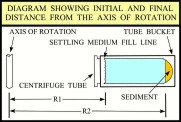 same rate as the actual particle. To obtain the correct results, the user
must exercise care to ensure the the other values are in the proper units
required by the program and when determining the initial (R1) and final
(R2) distances from the axis of rotation. Because of mechanical differences
in the designs of individual centrifuges, the user must measure these distances
on the specific piece of equipment being used. The units of R1 and R2 are
unimportant because they cancel out in the equation.
same rate as the actual particle. To obtain the correct results, the user
must exercise care to ensure the the other values are in the proper units
required by the program and when determining the initial (R1) and final
(R2) distances from the axis of rotation. Because of mechanical differences
in the designs of individual centrifuges, the user must measure these distances
on the specific piece of equipment being used. The units of R1 and R2 are
unimportant because they cancel out in the equation.
PROCEDURE FOR
SEPARATION OF SILT AND CLAY
BY CENTRIFUGATION |
Materials Required for Centrifugation:
-
marking pencil
-
labeling tape
-
plastic centrifuge tubes (~50 ml) with
-
caps
-
centrifuge tube rack
-
squeeze bottle with distilled water
-
plastic beakers
-
dispersant (sodium hexametaphosphate)
-
spatula
-
ultra-sonic probe
-
lab tissues
-
thermometer
-
timer
|
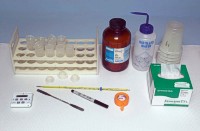 |
| If the supplied centrifugation program is to be used, the operator
should first determine the necessary information (initial and final distances
from the axis of rotation, and the acceleration and deceleration times
of the centrifuge for various speeds (rev./min.) and construct a table
of run times for common temperatures. |
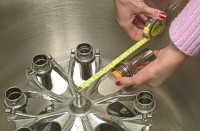 |
| Apply labeling tape to the top edge of the centrifuge tube and label
the tape with the marking pencil. Note: the bottom edge of the tape can
act as a guide facilitating equal filling of the tubes that will keep the
centrifuge in balance. Apply labeling tape to and label the plastic beakers. |
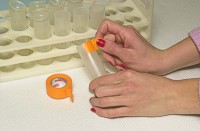 |
| Pour enough sample into the centrifuge tubes to fill the rounded part
of the bottom of the centrifuge tubes. Note: The powder from the randomly
oriented aggregate mounts can be used. |
 |
| Add a small amount (about 0.25 g) of dispersant to the centrifuge tubes.
The dispersant will cover the tip of a narrow spatula as shown. |
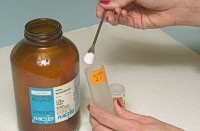 |
| Add distilled water to the bottom edge of the labeling tape. Place
a cap on the centrifuge tube and shake the tube to homogenize the suspension. |
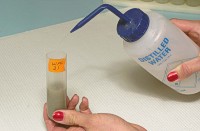 |
| Disperse the sample for 15-20 seconds with the ultrasonic probe. Rinse
the tip of the ultrasonic probe with distilled water and wipe it dry with
lab tissue between sonifications. |
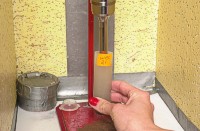 |
| Check the water temperature and find centrifugation times in minutes
and seconds from the prepared table. |
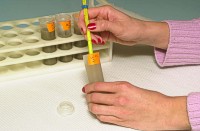 |
| Turn on the power switch and press Stop/Open. This releases the safety
latch and allows the cover of the centrifuge to be opened. Place the tubes
in the centrifuge. Be sure that the centrifuge is balanced by having opposite
tubes filled equally; 2, 4, 6, or 8 tubes may be used. Close cover. |
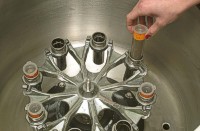 |
| Adjust the speed control, set the machine's timer to hold, adjust the
brake, press start on the centrifuge, and start the timer. Note: the timers
on most commercial centrifuges are not accurate enough to use for silt
and clay fraction separations. When the total run time minus the deceleration
time (T-td) has expired on the timer, press stop. The speed should read
near zero when the calculated total time is reached. |
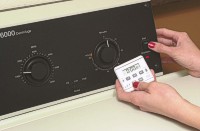 |
| Remove tubes from the centrifuge, pry off caps, and pour the supernatant
liquid into the plastic beakers. Be careful that the sediment on the bottom
of the tubes is not poured off. If the silt and clay fractions are to be
completely separated, repeat the centrifugation procedure until the supernatant
is reasonably clear (4-5 times). |
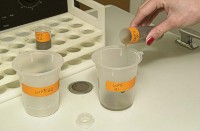 |




 We have written a program based on Stoke's Law that calculates centrifuge
run times and speeds for particles of various diameter and density in media
of different temperature, specific gravity, and viscosity (Poppe and others,
1988). The program, which was written in Unisoft C and implemented on UNIX
system V, is fast, interactive, allows the user to select all particle-
and medium-related parameters, and is not specific to any one piece of
centrifugation equipment.
We have written a program based on Stoke's Law that calculates centrifuge
run times and speeds for particles of various diameter and density in media
of different temperature, specific gravity, and viscosity (Poppe and others,
1988). The program, which was written in Unisoft C and implemented on UNIX
system V, is fast, interactive, allows the user to select all particle-
and medium-related parameters, and is not specific to any one piece of
centrifugation equipment.
 same rate as the actual particle. To obtain the correct results, the user
must exercise care to ensure the the other values are in the proper units
required by the program and when determining the initial (R1) and final
(R2) distances from the axis of rotation. Because of mechanical differences
in the designs of individual centrifuges, the user must measure these distances
on the specific piece of equipment being used. The units of R1 and R2 are
unimportant because they cancel out in the equation.
same rate as the actual particle. To obtain the correct results, the user
must exercise care to ensure the the other values are in the proper units
required by the program and when determining the initial (R1) and final
(R2) distances from the axis of rotation. Because of mechanical differences
in the designs of individual centrifuges, the user must measure these distances
on the specific piece of equipment being used. The units of R1 and R2 are
unimportant because they cancel out in the equation.